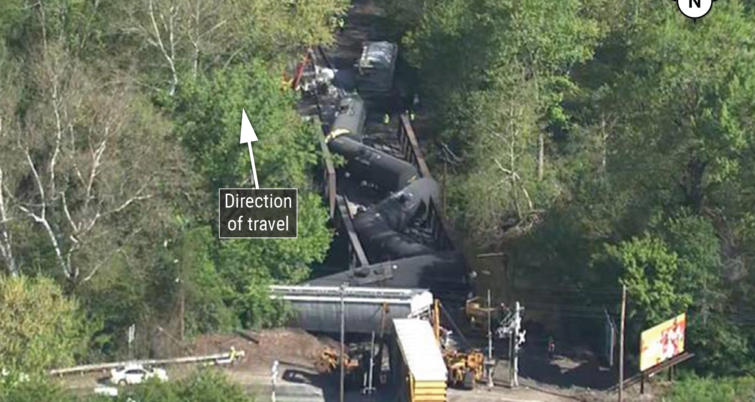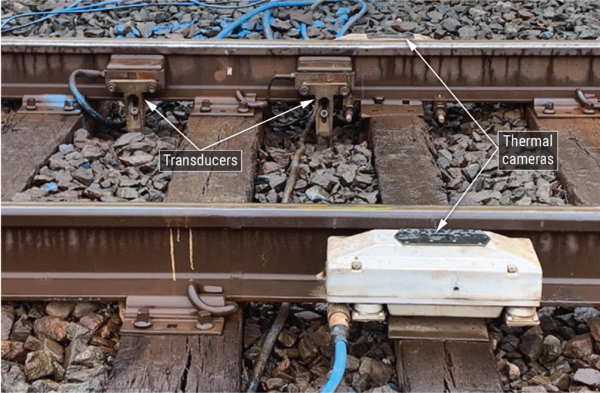NTSB Preliminary Report – Norfolk Southern Derailment in May 2023
Written by David C. Lester, Editor-in-Chief
WASHINGTON – The National Transportation Safety Board yesterday released its preliminary report on a Norfolk Southern train derailment that occurred in New Castle, Pa. on May 10, 2023. [1]
What Happened
This information is preliminary and subject to change. Release Date 1 June 2023
On May 10, 2023, about 10:57 p.m., northbound Norfolk Southern Railway (NS) general merchandise freight train 14M derailed nine mixed-freight railcars on the Youngstown Line at milepost (MP) 76.56 in New Castle, Pennsylvania.[1](See figure 1.) The derailed equipment included one hazardous material tank car, which was not breached, that contained paraffin.[2] There were no reported fatalities or injuries. NS estimated damages to equipment and track infrastructure to be about $6.1 million. At the time of the accident, visibility conditions were dark and clear; the weather was 52°F with no precipitation.
The crew of train 14M consisted of one engineer and one conductor. Their train was composed of 1 head-end locomotive, 144 loaded railcars, 69 empty railcars, and 2 distributed power locomotives positioned mid-train. The train weighed 19,993 tons and was 12,724 feet long. Train 14M was traveling about 28 mph at the time of the derailment, less than the maximum authorized timetable speed of 40 mph. [3] Train movements near the derailment site were authorized by wayside signal indications and coordinated by the NS Youngstown Line train dispatcher in Atlanta, Georgia.[4]
On the Youngstown Line of the Keystone Division, NS has equipped its rail network with wayside hot bearing detectors (HBDs) to measure the temperature of wheel bearings while trains are en route.[5] The function of the HBD is to detect overheated bearings, provide real time audible alarm messages to train crews, and alert railroad technicians monitoring the advanced train control (ATC) system.[6] NS has established the following HBD alarm thresholds (above ambient temperature) and criteria for bearings:
- Between 170°F and 200°F, warm bearing (non-critical); the train must immediately reduce speed to 8 mph or slower until the rear of the train clears the detector, at which point the train must be stopped for inspection
- A difference between bearings on the same axle greater than or equal to 115°F (non-critical); an alert is sent to the ATC desk
- Greater than 200°F (critical); the crew receives a critical alarm, and the train must be immediately stopped for inspection [7]
Train 14M departed Conway Yard on the Youngstown Line about 6:36 p.m.[8] The HBD at MP 91.9 was the first HBD the train encountered after departing Conway Yard. Preliminary data from HBD data logs indicate that the head end of train 14M traversed the MP 91.9 HBD about 10:13 p.m. The HBD recorded a temperature 253°F above ambient temperature for the east-side bearing on axle 671 (an axle on the 164th railcar).[9] Radio transmission records show that the HBD transmitted a critical hot wheel bearing alarm message for railcar 164 about10:17 p.m. The HBD repeated the alarm message about 10:19 p.m. Data logs do not show that the ATC desk received an alert. About 38 minutes later, train 14M derailed railcars 164–172.
While on scene, National Transportation Safety Board (NTSB) investigators recovered burned-off bearing components from the 164th railcar; examined and tested railroad equipment; reviewed data from data logs, the lead locomotive’s event recorder, and forward-facing and inward-facing image recorders; and completed interviews.
During review of signal data logs, NTSB investigators found that signal maintainers had performed maintenance on the Youngstown Line between Conway Yard and New Castle, Pennsylvania, on May 8, 2023. Maintenance activity included detaching and re-attaching track-mounted components of the HBD at MP 91.9.[10] Postaccident on-scene testing showed that the HBD’s transducers were attached incorrectly and reporting reversed train travel directions (that is, a northbound train would be reported as southbound).[11] (See figure 2.) NS’s ATC system requires an accurate report of train travel direction to interpret HBD data. Under NTSB investigators’ direction, signal maintainers corrected the transducers’ positions. In subsequent tests, NS technicians at the ATC desk in Atlanta confirmed that they had received usable HBD data.

Figure 2. Photo of the HBD at MP 91.9 on rail track.
Postaccident examinations did not identify conditions that would have prevented the HBD from transmitting an alarm message. However, NTSB investigators reviewed the inward-facing image recorder and audio data from the head-end locomotive of train 14M and did not find evidence of an audible alarm being broadcast over the locomotive radio.
NTSB investigators completed an examination of the locomotive’s ultra-high frequency radio communication system. Preliminary results showed the locomotive’s radio was functional; however, investigators found a loose coaxial connection between the antenna and the radio. On May 16, 2023, NS sent the radio to its radio shop in Roanoke, Virginia, for further analysis and will provide the results to the NTSB.
The NTSB’s investigation is ongoing. Future investigative activity will focus on analysis of the 164th railcar’s wheelset and bearing, NS use of HBDs, and NS railcar inspection practices.
Parties to the investigation include the Federal Railroad Administration; the Pennsylvania Public Utility Commission; NS; the International Association of Sheet Metal, Air, Rail and Transportation Workers; the Brotherhood of Railroad Signalmen; and the Brotherhood of Locomotive Engineers and Trainmen.
______________________________________________
[1] (a) All times in this report are local time. (b) Train 14M was traveling from Conway, Pennsylvania, to Buffalo, New York.
[2] Under Title 49 Code of Federal Regulations Part 171.8, a hazardous material is “a substance or material that the Secretary of Transportation has determined is capable of posing an unreasonable risk to health, safety, and property when transported in commerce, and has designated as hazardous under section 5103 of federal hazardous materials transportation law (Title 49 [United States Code] Section 5103).”
[3] The authorized speed was set by NS Pittsburgh Division, Northern Region, Timetable No. 1.
[4] NS train dispatchers direct and coordinate railroad traffic, issue permits and authorities, monitor all rail movements, and maintain electronic records.
[5] An HBD is a type of wayside defect detector that includes a sensor to detect passing trains and an upward-pointing thermal camera on each rail to measure independently the temperature of the wheel bearing at either end of each axle.
[6] NS’s ATC system identifies HBD trends that may become critical. NS technicians monitor the ATC system from the ATC desk in Atlanta, Georgia.
[7] See NS Operating Rules, Rule 147, revised January 1, 2019.
[8] Conway Yard is in the Fort Wayne Line of the Keystone Division and is about 23 miles from the point of derailment.
[9] This position number omits locomotives; the 164th railcar was the 167th piece of equipment in the consist, or “at line 167.” All railcar position numbers in this report omit locomotives.
[10] Signal maintainers are responsible for the installation, maintenance, inspection, and testing of railroad signal systems, highway–rail grade crossing warning systems, and the necessary system components for adjustment, repair, or replacement, as well as submitting the associated record-keeping and reporting requirements.
[11] On an HBD, the transducers are devices that convert the magnetic signature of a passing wheel into an electrical signal.





